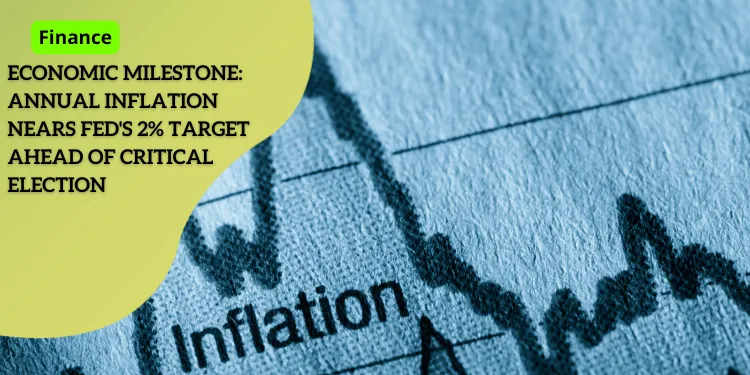Economic Milestone: Annual Inflation Nears Fed’s 2% Target Ahead of Critical Election

Anúncios
The latest data shows significant progress toward the Federal Reserve’s goal, with the annual inflation rate dropping to 2.1% in September.
This is the closest it’s been to the Fed’s target of 2% since February 2021.
Anúncios
The core inflation rate, which excludes the volatile categories of food and energy, stands at 2.7%, still higher but moving in a positive direction.
Personal Consumption Price Expenditures Index
The personal consumption price expenditures (PCE) index, a less commonly known measure than the consumer price index (CPI), also shows encouraging signs.
Anúncios
The PCE index dropped to its lowest level since February 2021, indicating moderation in price pressures across a broad spectrum of goods and services.
Unlike the CPI, which places significant emphasis on housing costs, the PCE index is weighted differently.
This difference can sometimes offer a clearer picture of inflation trends by smoothing out extreme variations in categories like shelter costs, which have been persistently high.
Federal Reserve’s Outlook
Given these trends, many analysts expect the Federal Reserve to cut interest rates by 25 basis points at their upcoming meeting.
This potential rate cut follows a surprising half-percent reduction in September. Lower borrowing costs could further support consumer spending, potentially accelerating economic recovery.
Progress in taming inflation has been slow but steady, helping to shield the economy from drastic fluctuations.
While the core inflation rate remains slightly above the Fed’s target, it is on a downward trend, contributing to overall economic stability.
The drop in inflation rates could also bolster consumer confidence, as they experience more consistency in price levels.
This stability is crucial as we approach the end of the fiscal year and look forward to holiday season spending, a pivotal period for retailers and the broader economy.
Looking ahead, the labor market’s performance and consumer behavior will be critical factors in maintaining this momentum.
As we transition to examining labor market strength, we see how these metrics play into the broader narrative of economic growth and stability.
Labor Market Strength
Unemployment Claims and Job Additions
The labor market shows robust strength heading into the final quarter of the year.
Unemployment claims fell to 216,000 for the week ending October 26, beating forecasts of 230,000.
This decline is significant, especially considering the potential disruptions caused by hurricanes Helene and Milton.
It suggests a resilient job market that continues to defy negative expectations.
At the same time, the ADP report revealed an impressive addition of 233,000 new jobs in October.
This uptrend in private-sector employment highlights sustained employer confidence and a healthy labor demand.
These numbers surpassed predictions and underscore the economy’s capacity to generate work opportunities even amidst challenges.
October Jobs Report Forecast
The upcoming October jobs report is anticipated to show a slower pace of job gains when compared to September.
Economists project an increase of about 110,000 jobs, significantly lower than September’s addition of 254,000 jobs.
This expected deceleration is primarily attributed to the adverse effects of hurricanes and strikes affecting several key industries, including aerospace and manufacturing.
Despite these temporary slowdowns, the overall labor market remains strong.
Seasonal adjustments and the anticipation of holiday season hiring are also factors influencing the labor market dynamics as we approach year’s end.
This resilience in job creation, even in the face of natural and industrial disruptions, is indicative of a stable and adaptable economic environment.
Economic Health Indicators
The drop in unemployment claims and the high number of new jobs added are encouraging signs of robust economic health.
These trends, coupled with strong consumer confidence and rising consumer spending, contribute to a more optimistic outlook on the economy’s ability to maintain momentum.
Real wage gains and record corporate profits further underpin this positive narrative.
As businesses expand and consumers continue to spend, the economic engine appears well-oiled and capable of weathering upcoming challenges.
The focus now shifts towards the upcoming holiday season and how it will impact the broader economic picture.
Amidst these fluctuations, the labor market’s resilience offers a solid foundation as we move forward.
Consumer Confidence and Economic Growth
Boost in Consumer Confidence
September witnessed a significant uplift in consumer sentiment, driven by renewed optimism toward economic conditions.
This is reflected in the sharp rise of the Conference Board’s monthly consumer confidence index to 108.7, up from 99.2.
The index’s present situation component, which gauges consumers’ perspectives on the current state of the economy, surged by an impressive 14.2 points to reach 138.
This marked the index’s most substantial monthly gain since March 2021 and underscored the positive impact of potentially lower borrowing costs on consumer outlooks.
Robust GDP Growth
A crucial indicator of economic vitality, the Gross Domestic Product (GDP), showed strong growth bolstered by consumer spending and government investment.
This robust expansion highlights the economy’s ability to maintain momentum amidst the broader recovery efforts.
Strong consumer demand and increased government spending have been pivotal in driving this growth, reflecting a persistently buoyant economic landscape.
Positive Signs in Employment and Corporate Health
Employment figures added to the positive narrative.
In October, private payroll firm ADP reported 233,000 new jobs, surpassing expectations despite anticipated disruptions.
This strengthened the perception of a resilient job market and bolstered confidence in continuing economic recovery.
The impressive economic indicators were further supported by record corporate profits and notable real wage gains.
These elements painted a picture of an economy not only recovering but thriving.
Record highs in the stock market indices such as the S&P and the Dow, alongside the best wage growth in years, provide a compelling case for a healthy economic backdrop.
Heading Towards Continued Economic Consolidation
While the October jobs report is expected to show slower gains due to external factors like hurricanes and strikes, the overall economic trajectory remains positive.
The convergence of these strong indicators suggests a period of sustainable consolidation ahead.
Even with some concerns about holiday season performance, the underlying economic fundamentals appear solid.
The next chapter will explore the political ramifications of these economic trends, bearing significant implications for the upcoming election cycle.
Future Outlook
Federal Reserve’s Expected Rate Cut
The Federal Reserve is signaling a cut in interest rates by 25 basis points, aligning with its efforts to sustain economic momentum.
Analysts anticipate this move following a surprising half-percent rate cut in September.
Lower borrowing costs are essential to maintain the recent surge in consumer spending and boost economic activities during upcoming months.
Economic Recovery
The economy shows signs of steady recovery, with multiple positive indicators reinforcing this trend.
The personal consumption price expenditures index reveals a moderation in price pressures, with annual inflation dropping to 2.1% in September, the lowest since February 2021.
This moderation is critical in keeping the inflation rate near the Fed’s 2% target and keeping economic stability in check.
Holiday Season Concerns
Despite these favorable conditions, there are growing concerns about the performance of the upcoming holiday season.
Julia Pollak, Chief Economist at ZipRecruiter, expresses that “it doesn’t look like we are going into a strong holiday season.
” Factors such as the residual effects of hurricanes and ongoing strikes might dampen consumer activities and overall economic buoyancy.
Transition to the Next Topic
As we look towards the future, it’s essential to consider the interplay of these economic indicators and their broader implications.
Understanding these dynamics sets the stage for addressing remaining economic challenges and seizing emerging opportunities.






